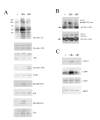Beta amyloid oligomers and fibrils stimulate differential activation of primary microglia
- PMID: 19123954
- PMCID: PMC2632990
- DOI: 10.1186/1742-2094-6-1
Beta amyloid oligomers and fibrils stimulate differential activation of primary microglia
Abstract
Background: Beta amyloid (Abeta) peptides are the major constituents of the senile plaques present in Alzheimer's diseased brain. Pathogenesis has been associated with the aggregated form of the peptide as these fibrils are the conformation readily found in the plaques. However, recent studies have shown that the nonaggregated, soluble assemblies of Abeta have the potential to stimulate neuronal dysfunction and may play a prominent role in the pathogenesis of Alzheimer's disease.
Methods: Soluble, synthetic Abeta1-42 oligomers were prepared producing mainly dimer-trimer conformations as assessed by SDS-PAGE. Similar analysis demonstrated fibril preparations to produce large insoluble aggregates unable to migrate out of the stacking portion of the gels. These peptide preparations were used to stimulate primary murine microglia and cortical neuron cultures. Microglia were analyzed for changes in signaling response and secretory phenotype via Western analysis and ELISA. Viability was examined by quantifying lactate dehydrogenase release from the cultures.
Results: Abeta oligomers and fibrils were used to stimulate microglia for comparison. Both the oligomers and fibrils stimulated proinflammatory activation of primary microglia but the specific conformation of the peptide determined the activation profile. Oligomers stimulated increased levels of active, phosphorylated Lyn and Syk kinase as well as p38 MAP kinase compared to fibrils. Moreover, oligomers stimulated a differential secretory profile for interleukin 6, monocyte chemoattractant protein-1 and keratinocyte chemoattractant when compared to fibrils. Finally, soluble oligomers stimulated death of cultured cortical neurons that was exacerbated by the presence of microglia.
Conclusion: These data suggest that fibrils and oligomers stimulate unique signaling responses in microglia leading to discrete secretory changes and effects on neuron survival. This suggests that inflammation changes during disease may be the consequence of unique peptide-stimulated events and each conformation may represent an individual anti-inflammatory therapeutic target.
Figures




References
-
- Selkoe DJ. Amyloid beta-protein and the genetics of Alzheimer's disease. J Biol Chem. 1996;271:18295–18298. - PubMed
Publication types
MeSH terms
Substances
Grants and funding
LinkOut - more resources
Full Text Sources
Other Literature Sources
Research Materials
Miscellaneous

